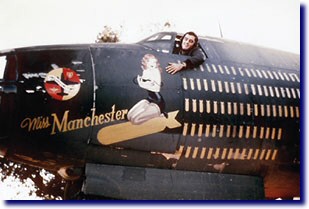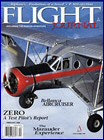![]()
Marauder
- A Pilot's Story
"No Visible Means of Support"
by
Charles O'Mahony, 441st Bomb Squadron
|
I didn’t dwell on it until much later--the pure happen-stance that made Trunk put me on aircraft One Six with Hubbard, and not on the doomed Zero Six. Eventually, I realized that when flying in combat, our fate wasn’t decided on the mission. It was decided the night before, when the operations officer put together the crews and arranged them in the formation, and the operations clerk typed the mission assignment sheet. The clerk was typing one man’s Distinguished Flying Cross and another man’s obituary.
In the next five days, I flew four more missions and then got sidetracked into flying squadron “errands.” I picked up jeep engines in Naples, flew a general to Corsica and brought back a planeload of beer from Algiers. By 14 August, I had only six missions and was still flying right seat. That day was a stand down, and we had our first ever afternoon briefing, giving us an in-depth preview of the next day’s operation -- all-out effort in support of the invasion of Southern France. “Our job tomorrow is to carpet-bomb the beach at Baie de Cavalaire to clear the land mines,” Capt. Smith said, pointing to a town just west of St. Tropez on the Riviera. “We drop at 0715 hours; the troops will hit the beach at 0800 hours. Takeoff will be at 0430. We got some search-lights we’re gonna aim down the runway to help you stay in formation on the takeoff. Bomb load will be 30 100-pound demos.“ “How we gonna carry 30 bombs when we only have 20 shackles?” lead bombardier Bill Garrey asked. “Ordnance says there’s room in the bomb bay to wire extra bombs to bombs, five on each side,” Smith said, “You won’t want to bring any bombs back .... Wouldn’t be too good landing on that lumpy runway?” What about taking off with the damned things on that lumpy runway? Capt. Smith said we were confined to base and, as soon as the briefing was over, there was a rush to Operations. Two mission sheets were thumbtacked to the bulletin board, and I was flying copilot for Bob Dinwiddie, lead ship of the third flight. I had flown two missions with Dinwiddie, and I was happy with my slot. Happier than “Pappy” Hurd, who was standing beside me, swearing softly. “What's your problem?” I asked. “I guess he pulled rank, lieutenant,” Pappy said. “Cap’n Bouchard’s flying in my place with Lt. Trunk.” He showed me where his name had been penciled out, Bouchard’s written in. Capt. Bouchard was our squadron Executive Officer. “Hey, Pappy; it’s a milk run, and we’re all goin’ to the same place.” “Yea, lieutenant, but I’m flying with a green crew -- back here -- and it’s a night takeoff. Trunk has over 60 missions; he knows what he’s doing.” Pappy had a point there. A night-formation takeoff, with an experimental bomb load, bombs wired to bombs, was not a good time to be flying with a short-timer. It was still pitch dark when the trucks dropped us off at our aircraft at 0400. To avoid confusion, crew chiefs had positioned the planes the evening before in their order of takeoff. Eighty marauders, more than a mile of airplanes, were lined up wingtip to wingtip on each side of the field, and the six. Hollywood-style searchlights were already beamed down the runways. With their Plexiglas turrets and .50-caliber machine guns glinting, the majestic rows of 320th and 319th bombers facing each other from opposite sides of the field looked like armored knights ready to joust.
At 0420, Dinwiddie started the engines, and after a few minutes, the plane on our right moved out and we rolled in behind. We were still taxiing toward the end of the runways when takeoffs in flights of three began. The searchlights behind them cast long, eerie shadows down the runway, and the planes were rim-lighted silhouettes until they hurtled past. When we took off, Dinwiddie held it on the ground a little longer than usual, then added 10mph to our climb airspeed, trying to give our wingmen a little wider envelope of control. Shortly after we took off, a red glare filled our cockpit and we heard a muffled explosion. Dinwiddie, concentrating on the instrument panel, shrugged his shoulders. We climbed on course toward Isla de Asinara on the north tip of Sardinia, and in the plum-blue dawn, the flights of three rendezvoused into squadrons of nine. When we moved in low and on the left of our squadron lead, his left wingman was missing – Trunk’s slot Capt. Berge called for a spare to fill in, and a plane slid in over us from our left, close enough for me to return the tail gunner’s wave. Where was Trunk? I wondered; but the invasion fleet started to appear below us, and I was mesmerized. One moment there was nothing, then they were everywhere. We were flying in sunlight, but two miles below us, the ships were chalking parallel white lines across a leaden sea. There were carriers, battleships, cruisers, strings of C-47s and fighter formations darting between the holes in the clouds, too fast to identify. I couldn’t grasp that we were part of this; I had a detached feeling, as though I was watching a newsreel. Over the target there was 7/10 cloud cover. It had been briefed as a “milk run” -- no flak, no fighters -- so our squadron bombardier made a second run on the target to make sure he had the beach where he wanted it in the crosshairs of his Norden sight. When we dropped, I watched two “wired” bombs from the lead ship clang together, nose and tail, and when their arming vanes spun off, they exploded in a beautiful red, yellow and black fireball. Jagged fragments of the bomb casings ripped through our flight. Nobody hurt but, damn, we almost got shot down by our own bombs. Our strike was a good one, and we started the long glide back to Sardinia thinking maybe we had done some good for the GIs who, in minutes, would be hitting the beach. When we climbed down out of the plane at Decimo, our grim-faced crew chief said, “Trunk bought the farm.” The red glare we had seen right after takeoff was Zero Two, Paul Trunk’s plane, flying into the side of a low hill not far off the end of the runway. “Anybody make it?” Dinwiddie asked.
Sgt. Lowther shook his head. “Afraid not, lieutenant. They’re finito.” Paul Trunk was flying his 62nd mission. Just three more and he would have rotated home to his wife and daughter, Paula, in Shippenville, Pennsylvania. He was as good a pilot as we had, and in addition to the six-man crew, there were two “stowaways” on Trunk’s plane. Everybody had wanted to see the big show. There was never any explanation why Trunk had made the difficult formation takeoff smoothly then banked gently down and left into Mt. Azza, a hill less than 600 feet high. At the end of September, the 320th reluctantly left Sardinia Allied ground forces had pushed ahead, and their battle lines were getting to the edge of the B-26’s range. We moved north to Corsica to be closer to the action. Flying off Corsica was challenging: a short, slippery, steel-mat runway situated in the turbulent lee of a mountain. On my last flight out of Sardinia, I took a last look back at Decimo’s long, forgiving runways. They had allowed me to make mistakes and stay alive while was learning to fly a B-26 with a load of bombs and ammo. Decimo had nursed me through my short-timer days, and I would always be grateful.
|

Copyright(c) 2003 320th History Preservation. All rights reserved.























